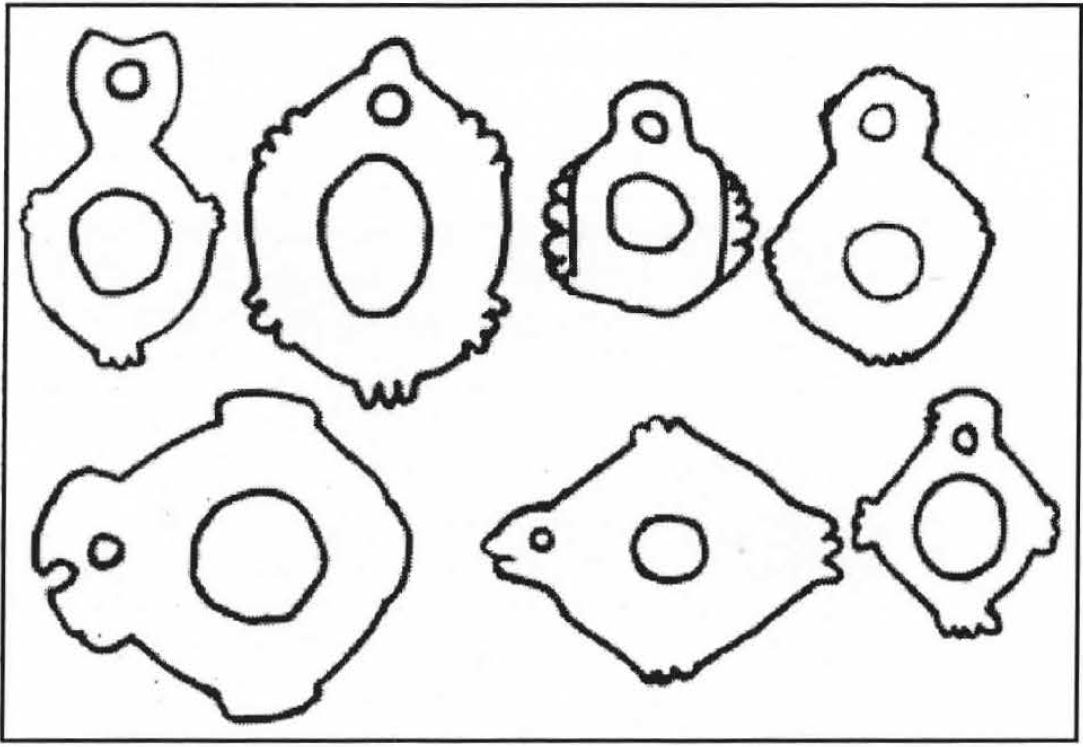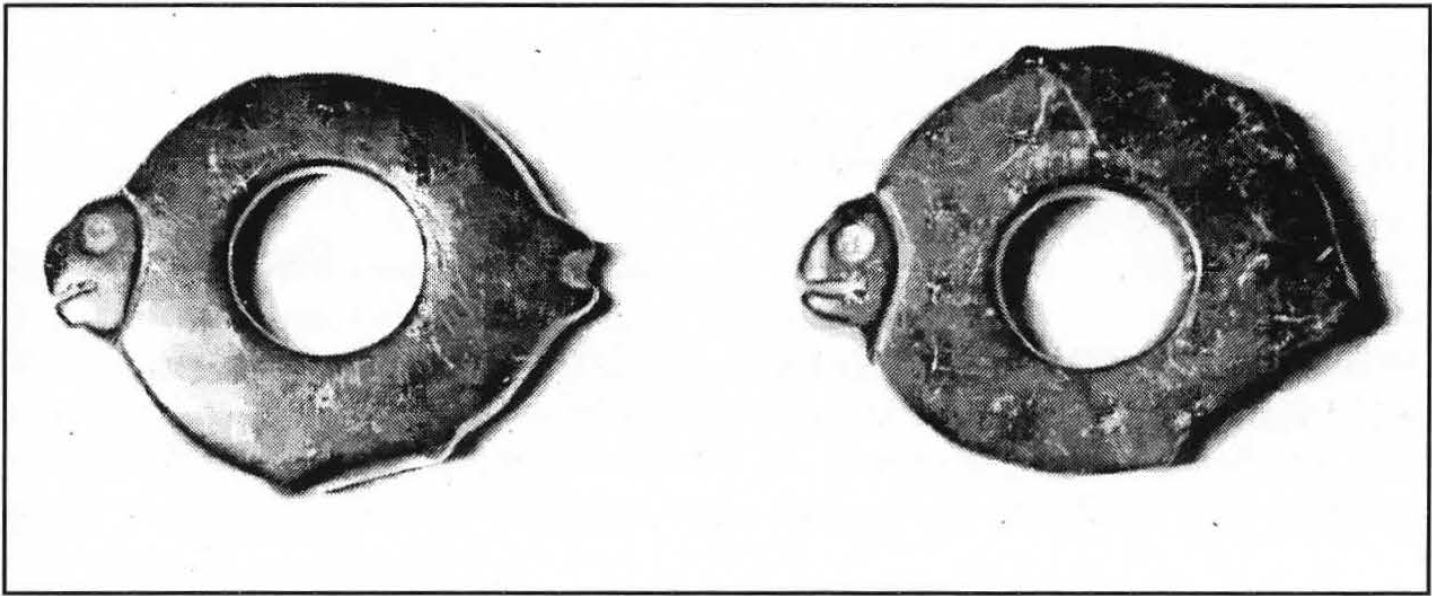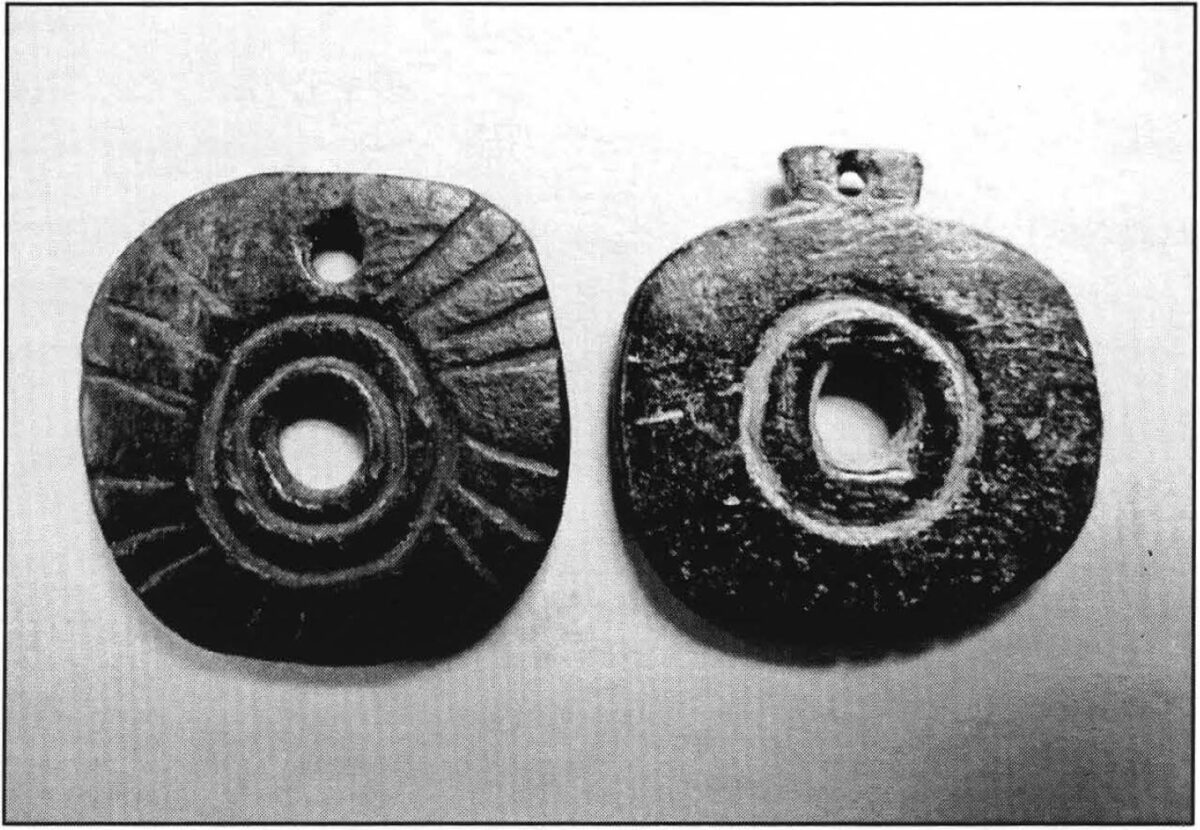January 30, 2011
By Grant Keddie

There are a variety of small artifacts found on the Northwest Coast that are often assumed to be forms of body adornment. Some of these likely had other functions. Three examples described here might normally be assumed to be pendants, I think we should consider the possibility that these may have been used as bird leg rings for holding live decoy birds or pets.
A common type of artifact in Polynesia is the kaka poria or bird leg ring made of stone or whale, bird and human bone. They were used to hold tame kaka birds (Nestor meridionalis) as a decoy for capturing wild birds in the forest (Phillips 1955:145). The leg of the tame bird was held in a larger hole and the attached string tether was generally tied through a smaller hole located in a protrusion from the larger ring or just inside the edge of the ring (Figure 1 below).
The vocalizations of the tethered birds attracted wild birds to local branches rigged with snares that would be pulled closed with

A characteristic of these artifacts are sets of three lines or protruding parts that are interpreted as representing bird feet, or other extensions that represent bird tails or bird heads.
Columbia River
A pair of rings with a parrot-like head protruding from each was found at the Indian Well Site on the Columbia River in Oregon (Figure 3).
One of these has a protrusion opposite the head with a broken line hole. The other is similar, but with part of this section broken off. There are slight protrusions on the top and bottom which may represent feet.
These are described as carved stone rings by Emory Strong (1959:131-132), who comments that: “Rings are quite rare. The most of those found came from the Condon and Indian Well sites, but a few have been found elsewhere, practically all of them in The Dalles area. Fig. 46 shows a pair of carved rings found together in the Indian Well site.”
British Columbia
Two examples of possible bird leg rings from British Columbia are in the collection of the Royal B.C. Museum (Figure 2 above).
One, DeRt-7:3, was a surface find from a shell midden site at Aiken Point on Mayne Island. It is a flat, slightly oval, ground soapstone (28mm x 28.5mm; 4mm th.) with a central 5mm hole. An incised 12mm circle around this hole has produced a 3mm high ring around the hole on both sides.
On one edge of the artifact is a small extension (4mm x 8mm) shaped like the thick end of a triangle. This extension has a small 2mm hole in the middle. On the edge opposite the extension is a row of three decorative grooves, 2mm apart, cut across the edge. It weighs 5.1 grams.
Another example, EbRj-Y: 1172, is from the general area of Lytton. It is a flat, slightly squarish, ground soapstone-like

material (28mm; 3mm th.) with a central 5mm hole. On side 1 there are two incised circles around this hole (outer 15mm diam.) that have produced two 3mm raised rings. Side 2 has only a single raised ring (10mm diam.). A small 3mm hole is located close to the edge above the larger hole. On side 1 there are ten grooved lines that extend from the circle around the central hole toward the edge. A group of three lines on each side of the central hole with a group of two lines between these at the bottom and a single line on each side of the upper hole. Side 2 has 12 radiating lines with three groups of three and one of four lines. It weights 4 grams.
Discussion
We do not have direct ethnographic information about the use of these artifacts on the Northwest Coast. However, we do know that it was not uncommon for First Nations to keep birds as pets (Elmendorf and Kroeber, 1992:115, n 89-90). Ray notes that Interior Salish speakers kept grouse, magpies, prairie chickens, ducks and geese (Ray 1942:124). Many species of birds were caught in snares and some, like Eagles, were enticed by decoy food and caught with a snared pole as well as by hand (Drucker 1950:175). A Quinault consultant of Olson (1936:137), who was bom on the Washington coast about 1835, noted the keeping of numerous pets, which included “all manner of birds.”
Tethers may also have been used for other animals. The heads on the two rings from the Dalles area could be interpreted as turtle-like.
Conclusion
In the two artifact examples from southern B.C., the three notches in one and the groups of three lines in the other are reminiscent of the bird foot patterns on the Polynesian foot rings. Considering these, with the more intriguing pair of rings with animal heads from the Columbia River—could these be bird leg rings? This is presented here as speculation, but as the archaeological sample builds up; this may be a worthy subject to pursue.
References
Best, Elsdon. 1942. Forest Lore of the Maori. Dominion Museum Bulletin (Wellington, New Zealand) 14:250.
Drucker, Phillip. 1950. Cultural Element. Distributions:XXVI. Northwest Coast. Anthropological Records (University of California Press, Berkeley and Los Angelas) 9:3.
Elmendorf, William and A.L. Kroeber. 1992[ 1960]. The Structure of Twana Culture. With Comparative Notes on the Structure of Yurok Culture. Washington State University Press, Pullman, Washington.
Olson, Ronald. 1936. The Quinault Indians. University of Washington Press, Seattle and London.
Phillips, W.L. 1955. Notes with Illustrations of Maori Material Culture. Dominion Museum Records in Ethnology (Wellington, New Zealand) Vol. a, No. 4, November 1.
Ray, Verne. 1942. Cultural Element Distributions: XII. Plateau. Anthropological Records 8(2)99-262. University of California.
Strong, Emory. 1959. Stone Age on the Columbia River. Binforts & Mort, Portland, Oregon.
